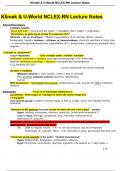Klimek & U-World NCLEX-RN Lecture Notes
Klimek & U-World NCLEX-RN Lecture Notes
Arterial Blood Gases
Acid/base balance:
“Bicarb both bolic” = bicarb and pH match = metabolic; don't match = respiratory
“As pH goes, so goes my pt. except for potassium (K+)”
Alkalosis = pH up, pt up/hyper: irritable, hyperreflexia (3-4), tachyp, tachyc, seizure,
borborygmi, hypoK+ Acidosis = pH down, pt. down/shutdown: chemical reactions in body stop
=> slow lethargy/obtunded/coma, hyporeflexia (0-1), bradycardia, bradypnea, paralytic ileus,
hyperK+
“?Causes vs. Symptoms?”
Lung = respiratory “Over ventilate under ventilate translate”
ventilation under/low = acidosis (poor gas exchange/high CO2) ambu bag
bedside ventilation over/high = alkalosis (increased gas exchange/low
CO2, blowing off CO2)
suction equipment for seizure bedside
All other = metabolic
Metabolic alkalosis = over suction, vomit = loss of stomach
HCL All other metabolic acidosis (diarrhea, dehydration,
burns)
MAC Kussmaul's = “M=metabolic AC=acidosis” compensatory resp. process for ONLY metabolic
acidosis
Electrolytes: “1st sx of all electrolyte imbalances is
paresthesia.” Urine output of 1 mL/kg/hr is within the normal range (0.5-
1.0 mL/kg/hr)
urine specific gravity is within a normal range (1.003 to 1.030), which can indicate normal
hydration
“Kalemias do the same as the prefix except for heart rate and urine output.” *cardiac*
Hyper: restless, tachypnea, diarrhea, spasticity, bradycardia w/peaked T,
oliguria Hypo: lethargy, bradypnea, ileus, flaccidity, tachycardia w/
depressed ST, polyuria
Never push potassium IV, IM or SubQ!!!!!! Not more than: 40 of K+ per L of fluid, or > 10ml / hr
Hyper K+ most dangerous => cardiac arrest
Tx: D5W w/ regular insulin: -> K+ in cell out of blood; fast but temporary
Kayexalate “K+ exits late”: (Na+) -> K+ excreted in stool, permanent but slow (hrs)
“Calcemias do the opposite of the prefix.” *skeletal muscle/nerve*
Hyper: bradycardia, bradypnea, constipation, lethargy
Hypo: tachypnea, tachycardia, diarrhea, agitation, Chevosteck sx = tap cheek ->
1 of
37
, Klimek & U-World NCLEX-RN Lecture Notes
spasm & Trousseau’s = tighten cuff -> hand spasm
“Magnesemias do the opposite of the prefix.”
Hyper: bradycardia, bradypnea, constipation, lethargy
Hypo: tachypnea, tachycardia, diarrhea, agitation
Hypernatremia: Dehydration; hot flushed dry skin; fluids; DKA, HHNK, DIp
Hyponatremia: Overload; diluted sodium, fluid restriction, lasix; SIADH Sx: circumoral paresthesia,
paresis
2 of
37
, Klimek & U-World NCLEX-RN Lecture Notes
Labs:
Priority: A = low; B = monitor; C = critical (do something); D = highest (do not leave bedside)
Creatinine kidney/renal fx 0.6 - 1.2 A test with contrast dye
(serum)
BUN 8 - 25 A assess for dehydration
INR Coumadin 2-3 >4 = C stop or hold, focused assessment, prepare,
(variation of PT) Warfarin call
K+ 3.5 - 5.3 < 3.5 = C assess heart
> 5.4 = C hold K+, assess heart, kayexalate, D5W,
ins
>/= 6 = D multiple nurses, stay with pt., hold, Assess
heart, kayexalate, D5W, insulin
Na+ 135 - 145 B assess: High =dehydration Low =overload
+LOC=C safety
BNP Congestive HF > 100 B monitor CHF, chronic
pH ABG 7.35 - 7.45 </= 6 = D assess vitals (alive?), call HCP!! NO HCO3!
PO2 ABG 78 - 100 < 77 = C assess respiratory, prep = give O2
Not SaO2 60s = D assess resp, prep intubation/ventilation,
resp fail call resp tx then HCP
PCO2 ABG 35 - 45 50s = C assess resp, prep = pursed lip breathing
60s = D assess resp, prep intubation/ventilation,
resp fail call resp tx then HCP
HCO3 bicarb ABG 22 - 26 A
SaO2 invalid: falsy elevates: anemia, dye procedure in past 42 hrs; PAD lowers
Hgb 12 - 18 8-11 = B assess bleeding, malnutrition
<8=C assess bleeding, prep blood, call HCP
Hct =3x(Hgb) 36 - 54 > 54 = B assess for dehydration
RBC 4-6 B
WBC total 5K - 11K < 5K = C assess infection
neutropenic precautions
ANC Absolute neutro > 500 <500 = C
CD4 AIDS > 200 <200 = C
Plt clot > 90K <90K =C assess bleeding
3 of
37
, Klimek & U-World NCLEX-RN Lecture Notes
> 40K <40K =D thrombocytopenia precautions
blood transfusion reaction:
remain with the client for 15 minutes after starting = monitor for signs of a reaction
= fever, chills, nausea, vomiting, pruritus, hypotension, decreased urine output, back
pain, dyspnea signs of a transfusion reaction occur:
Stop the transfusion immediately
Using new tubing, infuse normal saline to keep the vein open
Continue to monitor hemodynamic status and notify the health care provider and blood
bank.
Administer any emergency or prescribed medications to treat the
reaction vasopressors, antihistamines, steroids, or IV fluids
Collect a urine specimen to be assessed for a hemolytic reaction
Document the occurrence; send remaining blood/tubing set back to blood bank for
analysis
Transmission Based Precautions
Standard/Universal: hand washing, gloves
Droplet: H.flu -> epiglottitis: private room or
cohort Meningitis
Mask, gloves, handwashing, pt. mask out of room, disposable supplies, dedicated
equipment
Contact: anything enteric (fecal/oral=intestines) = Cdiff, HepA (A=anus), Cholera,
Dysentery, Staph, RSV- even though tx via droplet d/t kids and touching -> mouth,
herpes, shingles
RSV: Private room preferred or cohort same (based on culture)
Handwashing, Gown, gloves, disposable supply, dedicated
equipment
Airborne: mumps, measles, rubella, varicella, TB: (even though tx
droplet) Private required or cohort
Mask, gloves, handwashing, filter mask TB, pt. mask when leaving room, negative
airflow
PPE: off in alpha order: gloves, goggles, gown, mask
On in reverse alpha for Gs, but put on mask 2nd = gown, mask, goggles, gloves
neutropenic precautions:
A private room
Strict
handwashing
Avoiding exposure to people who are sick
4 of
37




